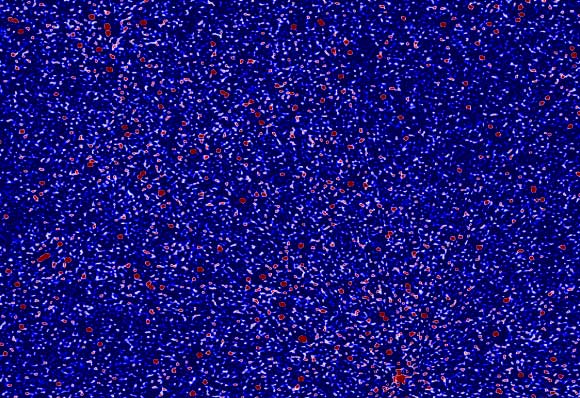Using the Murchison Widefield Array (MWA) telescope at CSIRO’s Murchison Radio-Astronomy Observatory, astronomers are searching for the elusive Epoch of Reionization, a period early in the Universe’s history that is predicted by theory but is yet to be detected using radio telescopes; it signifies the end of the Cosmic Dark Ages, roughly a billion years after the Big Bang, when the gas between galaxies shifted from opaque to transparent, allowing light from the first stars and galaxies to travel throughout the Universe.

A small part of the sky seen in radio waves by the Murchison Widefield Array. Image credit: Nunhokee et al. / ICRAR / Curtin University.
“Our research was conducted over two phases,” said Dr. Ridhima Nunhokee, an astronomer with the Curtin University node at the International Centre for Radio Astronomy Research (ICRAR) and ARC Centre of Excellence for All Sky Astrophysics in 3 Dimensions (ASTRO 3D).
“During the initial research, we obtained our first evidence of heating of the intergalactic medium, the gas between galaxies, 800 million years after the Big Bang.”
“To study this early period of the Universe, we must isolate the faint signal from the Epoch of Reionization, identify and remove every other source of radio waves in the Universe from their observations.”
“These include emissions from nearby stars and galaxies, interference from the Earth’s atmosphere, and even noise generated by telescope itself.”
“Only after carefully subtracting these ‘foreground signals’ will the remaining data reveal signals from the Epoch of Reionization.”
“From this research, we have developed methods to deal with the foreground contamination, and subtract the signals we don’t want, but also better understand our telescope and come up with a clean signal.”
“We’ve also been able to integrate about ten years of MWA data together, to observe the sky for longer than we ever have before.”
“That’s the other reason we’ve come closer than ever to detecting the signal.”
According to the team, the quality and quantity of this new dataset are what made this discovery possible.
A cold Universe would produce a signal which would have been visible in the new data.
The lack of that signal rules out such a ‘cold start’ to reionization, and means the Universe must have been ‘pre-heated’ before reionization happened.
“As the Universe evolved, the gas between galaxies expands and cools, so we would expect it to be very, very cold,” said Professor Cathryn Trott, an astronomer with the Curtin University node at ICRAR, ASTRO 3D and the Curtin Institute of Radio Astronomy.
“Our measurements show that it is at least heated by a certain amount. Not by a lot, but it tells us that very cold reionization is ruled out. That’s really interesting.”
“The research suggests this heating is likely driven by the energy from early sources of X-rays from early black holes and stellar remnants spreading through the Universe.”
The results appear in two papers in the Astrophysical Journal.
_____
C.D. Nunhokee et al. 2025. Limits on the 21 cm Power Spectrum at z = 6.5–7.0 from Murchison Widefield Array Observations. ApJ 989, 57; doi: 10.3847/1538-4357/adda45
Cathryn M. Trott et al. 2025. Improved Limits on the 21 cm Signal at z = 6.5–7.0 with the Murchison Widefield Array Using Gaussian Information. ApJ 991, 211; doi: 10.3847/1538-4357/adff80




![The image shows NGC 1866 superimposed with a false color image from the MUSE data cube, where the ionized shell of the planetary nebula Ka LMC 1 is seen as a red ring. The grayscale insets illustrate the different size of the ionized shells of singly ionized nitrogen [N II] and doubly ionized oxygen [O III]. The magnified Hubble image near the center of the ring reveals the presence of a pale blue star -- most probably the hot central star of Ka LMC 1. Image credit: AIP / M.M. Roth / NASA / ESA / Hubble.](https://cdn.sci.news/images/2025/11/image_14348-Ka-LMC-1-104x75.jpg)


